
FNR-76

Pruning black walnut is an art, and this bulletin is intended to provide guidelines, not solutions, for all possible situations. Since each tree in each plantation and each owner is different, none of the photographs provided will look exactly like your trees. However, we hope the resemblance will be close enough to allow you to begin to get the feel of pruning and to decide what should be done in individual situations.
One theory argues for no pruning at all until the tree has developed a tall central stem. Knot-producing low branches on the main stem must then be pruned to allow the tree to develop high quality wood. It is often amazing how a small, crooked tree sometimes straightens without pruning. It is not so amazing, on the other hand, how often low forks, which limit the merchantable length of the tree to two to six feet, develop (Figure 1). All such forks can be avoided by the easy, properly-timed snip of the pruning shears.
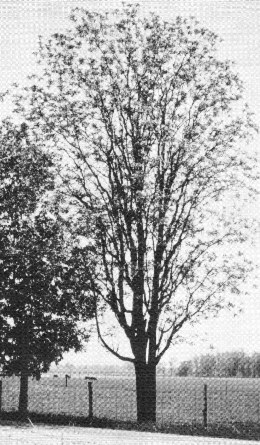
Pruning should begin one, or at the most, two growing seasons after the nursery seedling is out-planted and should continue annually until the desired log length has been reached. Pruning is best done in the dormant season from January through March. Sap may run from the wounds, but this will not harm the tree. Some pruning may also be done in late June or early July to remove multiple stems. This is particularly desirable after late spring frost damage. The principle that is most important to remember when pruning young black walnut trees is to look for overall tree balance. Any leader at the same height as the central leader will tend to force the central leader away from it. Once the competing leader is totally removed, the central leader has the opportunity to adjust and regain overall tree balance. This is because any tree (even crooked and bent black walnut) attempts to grow in an upright, vertical position. They will do this without the help of pruning, but they may produce two, three, four or more leaders (forks) to achieve that balance. Preferably, black walnut should gain its equilibrium by producing a single, straight central stem. That is where the art of pruning must be applied.
The most common correction necessary is the removal of multiple leaders (Figure 2). In most cases, only the straightest and usually the tallest of the leaders should be left (Figure 3). All lower branches that could conceivably compete with the chosen leader, on the side away from the direction in which the chosen leader leans, should be removed or cut back (Figure 3).
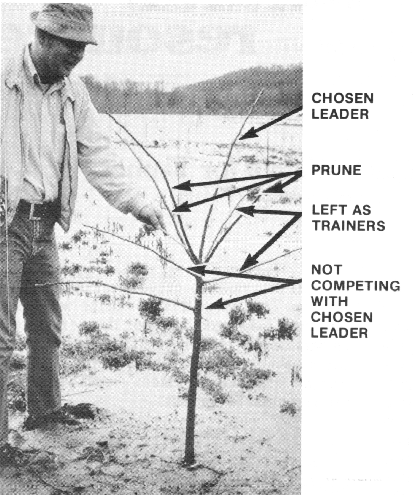
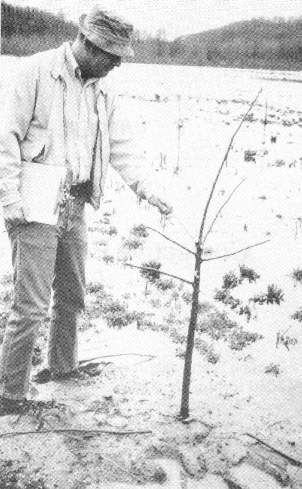
Stubs or short branches provide some balance and should never be allowed to remain opposite the chosen leader (Figure 4).
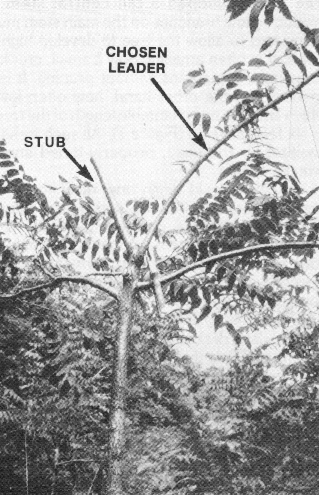
If you are fortunate enough to have a branch directly under the chosen leader, allow it to remain intact, since it will act as a trainer and force the chosen leader into an upright position (Figure 5). Remember the principle of tree balance.
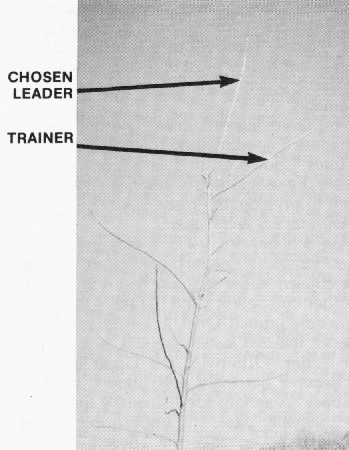
A variation of the multiple leader problem is the fork (Figure 6). The straighter of the two should be left.
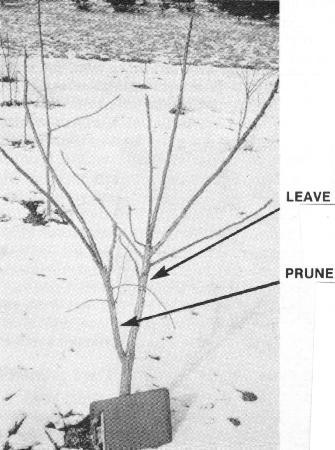
Occasionally the previous year's leader will die back producing a profusion of branches or multiple leaders (Figure 7). Again, all branches competing with the chosen leader should be removed (Figure 8).
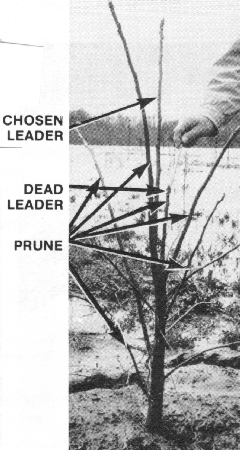
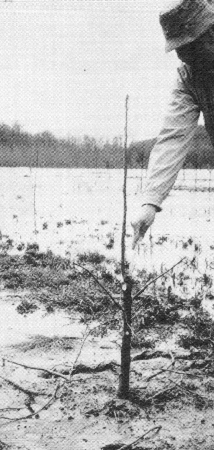
The only other pruning that may be necessary on young trees is to remove long branches that gain too much diameter (over one inch) or branches that interfere with machinery (Figure 9).
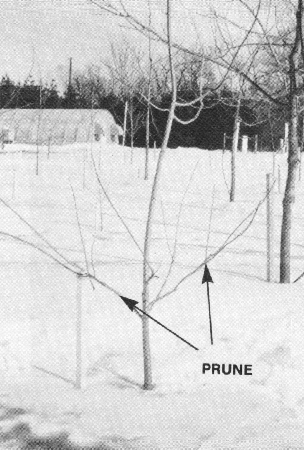
Remember: any branch removed for no real reason detracts from the total possible growth of that tree by removal of potential leaf area. Young trees with all or most branches removed tend to develop very slender stems and are susceptible to wind damage.
Taping opposing branches together has been advocated as a good method to straighten multiple leader trees.' However, it is very time consuming, and usually, by using the tree balance-chosen leader approach to pruning, the tree will straighten just as fast as with taping techniques.
Taping is done with 3/4 inch wide masking tape with 5 to 7 wraps. Opposing branches are crossed so that the chosen leader is straightest (Figure 10).
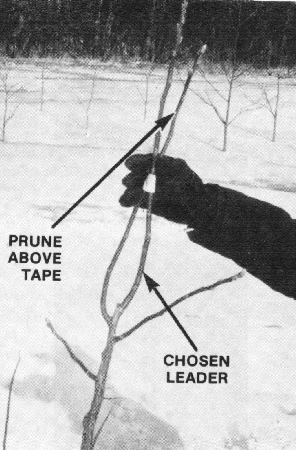
All other competitors and the tip of the undesirable leader are pruned. Only the largest in height and diameter of the two leaders should be used as the chosen leader. Otherwise the larger leader will usually become dominant even though its tip was pruned back. A serious fork is usually the result.
The following year, the undesirable leader is completely removed after the chosen leader has straightened (Figure 11). Taping should probably be attempted only when the chosen leader is nearly horizontal and little hope of its straightening using normal pruning techniques can be anticipated. Even so, 50 percent success is probably the maximum to be expected from this technique.
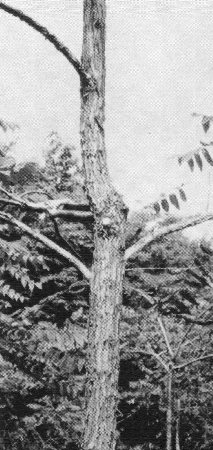
Much has been said and written about the virtues of cutting misshapen, nearly horizontal walnut seedlings back to the ground and allowing them to sprout back with a vigorous straight shoot. When a tree is completely without redeeming value, this is an attractive alternative.
However, pruning, especially at ground level, is a dwarfing or growth-slowing process. The tree will not regain its former height in a year or two. In fact, after ten years, one or two year old trees cut off at ground level never did catch up with those not cut off. 2 Improved form may not result and trees often fork or produce multiple stems in succeeding years anyway. Poor form is strongly inherited and this tendency generally continues throughout the life of the tree.
Extremely poorly-formed trees, beyond reasonable help, may require that large segments of the tree be removed. But, rather than pruning the tree back to the ground, it should be pruned back only to the point where the crookedness or damage begins, if that point is not greater than 2 inches in diameter (Figure 12). Stems greater than 2 inches in diameter at that point should be cut back to the ground. According to Robert Burke, Chief Forester with a noted veneer firm, a bud may be visible near the desirable cutoff point.3 A bud that is pointing upward should be favored. Side branches below the cutoff point will have to be cut back severely so that they do not compete for dominance. Some branches should be left so that not all energy goes into a single, wind-susceptible sprout at the cutoff point (Figure 12). Usually several buds will break and grow and, without further attention, a multiple-stemmed tree will develop again. Therefore, as soon as the new shoots grow one to two feet and become woody, all but one or two sprouts should be removed. Two or three sprouts may be left and tied together for mutual support. By the following year, the smallest or most crooked can be removed.
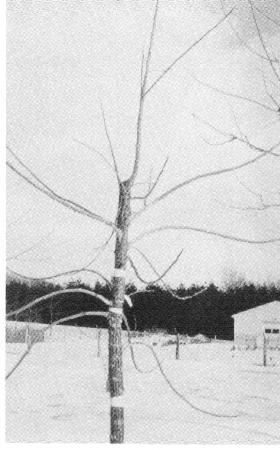
Keep in mind that in the future you will be thinning the plantation to favor the growth of the best formed trees. The most poorly formed trees will be removed in these thinnings.
As a black walnut tree grows in a plantation, removal of branches from the main stem is essential for the development of knot-free veneer quality wood. A rule-of-thumb is to never allow a branch to exceed 1 1/2 to 2 inches in diameter before removal. Pruning branches greater than 2 inches often leads to the development of decay. Up to half of the tree's main stem can be pruned free of branches with no harm to the tree. That is, a 24-foot tall tree could have as much as 12 feet of clear stem.
Branches larger than 2 inches in diameter may develop. If you desire a potential clear log length above that 2-inch diameter branch, it should be removed even though it may be above several other smaller-diameter branches that are allowed to remain for several years.
Side branches should not be pruned flush with the main stem. The collar or swelling at the base of the branch where it joins the main stem should be left.4 Apparently this collar has already begun the healing compartmentalization process that seals the branch off from the tree as part of the sequence of natural branch abscission. By leaving the branch collar, natural healing is accelerated and callus tissue covers the wound more quickly. Also, the cross sectional area of the wound that the tree has to seal over is much smaller. A practical advantage of leaving the collar is that pruning is faster and easier.
A variety of excellent pruning tools is available, and the following list is not intended to exclude any of these.
Until the trees are head high, the only tool required is a simple pruning snip (Figure 13).
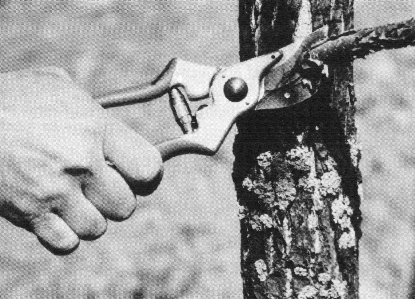
As the trees grow in height and branch diameter, several other tools become useful. The pole pruner can remove branches up to one inch in diameter at heights up to 25 feet (Figure 14). A small pruning saw (Figure 15) and/or the "Timberline" lopping shear (Figure 16) are necessary to remove larger diameter branches and forks.
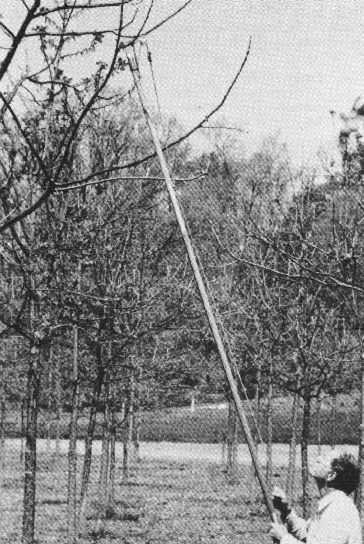
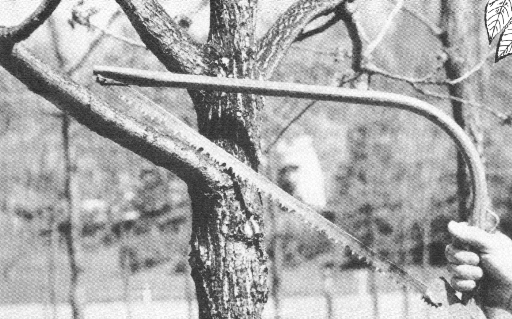
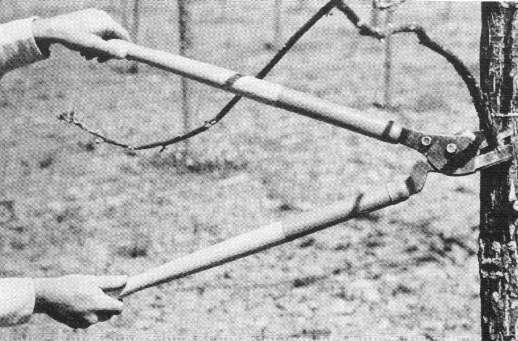
RR 10/94
1 Bey, Calvin f. 1972. Corrective pruning young balck walnut trees- a new twist. 63rd Northern Nut Growers Association Proc. Ames, Iowa, p.26-28.
2 Personal communication-Dr. Richard Byrnes, Department of Forestry and Natural Resources, Purdue (University, West Lafayette, Indiana.
3 Personal communication, Mr. Robert Burke, Chief Forester, Pierson- Hollowell Veneer company, Martinsville, Indiana.
4 Shigo, Alex L.; McGinnes, Jr., E. Allen; Funk, David T., and Rogers, Nelson F. 1979. Internal defects associated with pruned and non-pruned branch stubs in black walnut. USFS For. Serv. Res. Pap. NE-440, 27 p.
Cooperative Extension Work in Agriculture and Home Economics, State of Indiana, Purdue University and U.S. Department of Agriculture Cooperating. H.A. Wadsworth, Director, West Lafayette, IN. Issued in furtherance of the Acts of May 8 and June 30, 1914. It is the policy of the Cooperative Extension Service of Purdue University that all persons shall have equal opportunity and access to our programs and facilities.